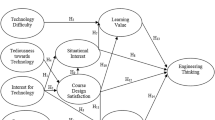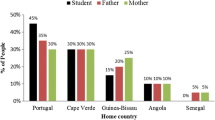Abstract
Engineers commonly use rules, theories and models that lack scientific justification. Examples include rules of thumb based on experience, but also models based on obsolete science or folk theories. Centrifugal forces, heat and cold as substances, and sucking vacuum all belong to the latter group. These models contradict scientific knowledge, but are useful for prediction in limited contexts and they are used for this when convenient. Engineers’ work is a common prototype for the pupils’ work with product development and systematic problem solving during technology lessons. Therefore pupils should be allowed to use the engineers’ non-scientific models as well as scientific ones when doing design work in school technology. The acceptance of the non-scientific models for action guidance could be experienced as contradictory by pupils and teachers alike: a model that is allowed, or even encouraged in technology class is considered wrong when doing science. To account for this, different epistemological frameworks must be used in science and technology. Technology is first and foremost what leads to useful results, not about finding the truth or generally applicable laws. This could cause pedagogical problems, but also provide useful examples to explain the limitations of models, the relation between model and reality, and the differences between science and technology.
Similar content being viewed by others
Notes
To what extent the transfer of problem solving skills from one domain to another is possible is an important question that has been (and still is) widely debated. That discussion is beyond the scope of this article.
References
Allchin, D. (1997). Rekindling phlogiston: From classroom case study to interdisciplinary relationship. Science and Education, 6, 473–509.
Allchin, D. (1999). How school science lies. URL http://www.tc.umn.edu/allch001/papers/lies.pdf, paper presented at the 5th International history, philosophy and science teaching conference. Accessed 2 September 2011.
Banks, F., & McCormick, R. (2006). A case study of the inter-relationship between science and technology: England 1984–2004. In M. J. de Vries & I. Mottier (Eds.), International handbook of technology education (pp. 285–311). Rotterdam: Sense Publishers.
Blonsky, G. B., & Blonsky, C. E. (1965). Apparatus for facilitating the birth of a child by centrifugal force. US Patent No. 3,216,423.
Bunge, M. (1966). Technology as applied science. Technology and Culture, 7, 329–347.
Cartwright, N. (1983). How the laws of physics lie. New York: Oxford University Press.
Cunningham, C. M., & Hester, K. (2007). Engineering is elementary: An engineering and technology curriculum for children. In Proceedings of the 2007 American society for engineering education annual conference & exposition.
Dakers, J. (Ed.) (2006a). Defining technological literacy. New York: Palgrave MacMillan.
Dakers, J. (2006b). Towards a philosophy for technology education. In Dakers (2006a), pp. 145–158.
de Vries, M. J. (2003). The nature of technological knowledge: Extending empirically informed studies into what engineers know. Techné, 6(3), 1–21.
de Vries, M. J. (2010). Engineering science as a “Discipline of the particular”? Types of generalization in engineering sciences. In I. van de Poel, & D. E. Goldberg (Eds.), Philosophy and Engineering, no. 2 in Philosophy of engineering and technology (pp. 83–93). Dordrecht: Springer.
de Vries, M. J., & Mottier, I. (Eds.) (2006). International handbook of technology education. Rotterdam: Sense Publishers.
Garratt, J. (2004). Design and technology. Cambridge: Cambridge University Press.
Hempel, C. G. (1994). The function of general laws in history. In M. Martin, L. McIntyre (Eds.), Readings in the philosophy of social science (pp. 43–53). Cambridge, MA: MIT Press. original work published 1942.
Hempel, C. G., & Oppenheim, P. (1948). Studies in the logic of explanation. Philosophy of Science, 15(2), 135–175.
Herschbach, D. R. (1995). Technology as knowledge: Implications for instruction. Journal of Technology Education, 7(1), 32–42.
International Technology Education Association. (2007). Standards for technological literacy, 3rd edn. Reston, VA: International Technology Education Association.
Johnsey, R. (1995). The design process—does it exist? International Journal of Technology and Design Education, 5, 199–217.
Klasander, C. (2010). Talet om tekniska system [Speaking of technological systems]. PhD thesis, Linköping University, Department of social and welfare studies, Norrköping, Sweden.
Koen, B. V. (2003). Discussion of the method. New York: Oxford University Press.
Kroes, P. (2000). Engineering design and the empirical turn in the philosophy of technology. In P. Kroes & A. Meijers (Eds.), The Empirical Turn in the Philosophy of Technology, no. 20 in Research in Philosophy and Technology (pp. 19–43). Oxford: Elsevier Science Limited.
Layton, D. (1993). Technology’s challenge to science education. Buckingham: Open University Press.
Lewis, T. (2004). A turn to engineering: The continuing struggle of technology education for legitimization as a school subject. Journal of Technology Education, 16, 21–39.
McCormick, R. (2007). Design aspects. In M. J. de Vries, R. Custer, J. Dakers & G. Martin (Eds.), Analyzing best practices in technology education (pp. 169–177). Rotterdam: Sense publishers.
Mitcham, C. (1994). Thinking through technology. Chicago: The University of Chicago Press.
Mitcham, C., & Holbrook, J. B. (2006). Understanding technological design. In Dakers (2006a), pp. 105–120.
Mumford, L. (1946). Technics and civilisation. Routledge, London, original work published 1934.
Niehaus, J. (2003). Device for cooling and tapping. US Patent No. 6,502,406.
Nussbaum, J., & Novick, S. (1982). Alternative frameworks, conceptual conflict and accommodation: Toward a principled teaching strategy. Instructional Science, 11, 183–200.
Pavlova, M. (2006). Comparing perspectives: Comparative research in technology education. In de Vries and Mottier (2006), pp. 19–32.
Rasinen, A. (2003). An analysis of the technology education curriculum of six countries. Journal of Technology Education, 15, 31–47.
Ropohl, G. (1997). Knowledge types in technology. International Journal of Technology and Design Education, 7, 65–72.
Sanders, M. (2009). STEM, STEM Education, STEMmania. The Technology Teacher pp. 20–26, December/January 2009.
Scriven, M. (1988). Explanations, predictions, and laws. In J. C. Pitt (Ed.), Theories of explanation (pp. 51–74). New York: Oxford University Press. original work published 1962.
Šesták, J., Mareš, J., Hubík, P., & Proks, I. (2009). Contribution by Lazare and Sadi Carnot to the caloric theory of heat and its inspirative role in thermodynamics. Journal of Thermal Analysis and Calorimetry, 97, 679–683.
Seymor, S. L. (1981). Shaping glass sheets by drop forming with pressure assist. US Patent No. 4,280,828.
Skolverket. (2008). Syllabuses 2000, revised version 2008, compulsory School. Skolverket [The Swedish National Agency for Education], URL http://www3.skolverket.se/ki/eng/comp.pdf, originally published 1994, revised 2000 and 2008. Accessed on 2 September 2011.
Skolverket. (2010). Del ur Lgr 11: Kursplan i teknik i grundskolan [Excerpt from Lgr 11: Syllabus for technology in compulsory school]. URL http://www.skolverket.se/content/1/c6/02/38/94/Teknik.pdf.
Taber, K. S. (2002). Multiple frameworks? Evidence of manifold conceptions in individual cognitive structure. International Journal of Science Education, 22(4), 399–417.
Taylor, W. J., Boudreau, J. A., & Cote, R. E. (1939). Pneumatic dispatch system. US Patent No. 2,176,439.
Todaro, C. L. (1997). Centrifugation. In H. C. Vogel, & C. L. Todaro (Eds.), Fermentation and biochemical engineering handbook (pp. 558–589). Westwood, NJ: Noyes publications.
Vincenti, W. G. (1990). What engineers know and how they know it. Baltimore, MD: The John Hopkins University Press.
von Wright, G. H. (1971). Explanation and understanding. Ithaca, NY: Cornell University Press.
Young, L. L., & Smith, D. P. (2004). Effects of vacuum on moisture absorption and retention by marinated broiler filets. Poultry Science, 83, 129–131.
Zesch, W., Brunner, M., & Weber, A. (1997). Vacuum tool for handling microobjects with a nanorobot. Paper presented at the ICRA’97, International conference on robotics and automation. doi:10.1109/ROBOT.1997.614405.
Author information
Authors and Affiliations
Corresponding author
Rights and permissions
About this article
Cite this article
Norström, P. Engineers’ non-scientific models in technology education. Int J Technol Des Educ 23, 377–390 (2013). https://doi.org/10.1007/s10798-011-9184-2
Published:
Issue Date:
DOI: https://doi.org/10.1007/s10798-011-9184-2




